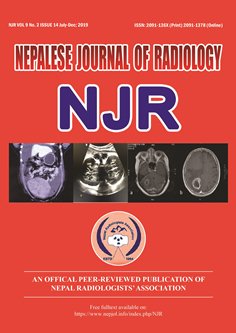Role of Multidetector Computerised Tomography in Evaluation of Proptosis
DOI:
https://doi.org/10.3126/njr.v9i2.27421Keywords:
Graves Ophthalmopathy, Orbital Neoplasms, RadiographyAbstract
Introduction: Proptosis is defined as bulging of eye anteriorly out of the orbit. Our main objective was to analyze the pattern of computerised tomographic findings in evaluation of proptosis. Computerised tomography (CT) is noninvasive, easily accessible, affordable and reliable imaging which helps in early diagnosis and prompt treatment.
Methods: A descriptive cross sectional study of total 58 patients presenting with proptosis referred to our department of radiology for computerised tomography evaluation during one year period were undertaken into study. The clinical information provided by ophthalmologist also helped our study to derive into conclusion. SPSS version 20 software was used for statistical data analysis.
Results: Out of 58 patients, the most common cause of proptosis was neoplasm constituting of 25 cases (43.1%). Retinoblastoma was the commonest orbital tumor. Out of remaining cases, 15 (25.8%) were infective, 14 (24.1%) were inflammatory, two (3.44%) were traumatic and remaining two cases (3.44%) had no definitive cause for proptosis. Bilateral proptosis was commonly associated with thyroid ophthalmopathy. Among the subjects 32 were male, 26 were female. Male: Female ratio was 1:1.23. Age group was ranging from 1 month to 73 years.Mean age was 26.4 ± 22 years.
Conclusions: Computerised tomography has an important role in distinguishing the different types of lesions based on their characteristics, location and extension prior to undertaking definitive surgical and medical treatment. Overall accuracy of CT in our study was 81%, sensitivity of 82.6%, specificity of 80.6%, positive predictive value of 76% and negative predictive value of 86.2%.
Downloads
Downloads
Published
How to Cite
Issue
Section
License
This license enables reusers to distribute, remix, adapt, and build upon the material in any medium or format, so long as attribution is given to the creator. The license allows for commercial use.




